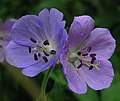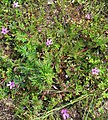Geraniaceae
| Geraniaceae | |
|---|---|

| |
| Geranium rotundifolium | |
| Scientific classification | |
| Kingdom: | Plantae |
| Clade: | Tracheophytes |
| Clade: | Angiosperms |
| Clade: | Eudicots |
| Clade: | Rosids |
| Order: | Geraniales |
| Family: | Geraniaceae Juss.[1] |
| Type genus | |
| Geranium L.
| |
| Genera | |
| |
Geraniaceae is a family of
The family comprises 830 species in five to seven genera. The largest genera are Geranium (430 species), Pelargonium (280 species) and Erodium (80 species).
Description

Geraniaceae are herbs or subshrubs(have more height than herb but Shotter than herbs). The Sarcocaulon are succulent, but other members of the family generally are not.
Leaves are usually lobed or otherwise divided, sometimes
.The
Geraniaceae are normally pollinated by insects, but self-pollination is not uncommon.[citation needed] A number of species are pollinated by the fly Moegistorhynchus longirostris.[6]
The
Differences between the genera
Taxonomy
Geraniaceae and Francoaceae are the two families included in the order Geraniales under the Angiosperm Phylogeny Group (APG) classification (APG IV).[7] There has been some uncertainty in the number of genera to be included. Stevens gives seven genera listed here,[8] while Christenhusz and Byng[9] state five genera.
Stevens also lists four synonyms of Geranium: Geraniopsis Chrtek Neurophyllodes (A. Gray) O. Degener Robertianum Picard Robertiella
Hypseocharis, with between one and three species, which comes from the south-west Andean region of South America, is considered the sister to the rest of the family. Some authors separate Hyspeocharis as a monogeneric family Hypseocharitaceae,[10] while older sources placed it in the Oxalidaceae. The genus Rhynchotheca has also been separated into the Vivianiaceae.
The Geraniaceae have a number of genetic features unique amongst angiosperms, including highly rearranged
Phylogeny
Recent comparison of DNA-fragments resulted in the following phylogenetic tree.[12]
| ||||||||||||||||
Distribution and habitat
Most species are found in temperate or warm temperate regions, though some are tropical. Pelargonium has its centre for diversity in the Cape region in South Africa, where there is a striking vegetative and floral variation.
Gallery
-
Herbarium specimen of Geranium rotundifolium showing mature fruits
-
Immature fruits of Erodium botrys
-
Actinomorphic flowers of Geranium pratense
-
Zygomorphic flowers of a garden geranium (genus Pelargonium)
-
Cultivated Pelargonium umbels
-
Erodium cicutarium
-
Another flower diagram (Pelargonium zonale, three abortive stamens)
-
A bush with flowers
References
- .
- ^ a b Aldasoro, Juan José; Navarro, Carmen; Vargas, Pablo; Sáez, Llorenç; Aedo, Carlos (2002). "California, a new genus of Geraniaceae endemic to the southwest of North America" (PDF). Anales del Jardín Botánico de Madrid. 59 (2): 209–216. Retrieved 2017-09-27.
- ^ PMID 28961907.
- PMID 28025289.
- PMID 29293992.
- ISSN 1681-5556.
- ^ APG IV 2016.
- ^ Stevens 2016.
- ^ Christenhusz & Byng 2016.
- ^ Watson, L.; Dallwitz, M.J. (March 2011). "Angiosperm Families - Hypseocharitaceae Weddell". The families of flowering plants: descriptions, illustrations, identification, and information retrieval. Version: 4th. Archived from the original on October 9, 2012. Retrieved April 14, 2012.
- ^ Röschenbleck, J. , Albers, F., Müller, K., Weinl, S., Kudla, J. Phylogenetics, character evolution and a subgeneric revision of the genus Pelargonium (Geraniaceae). Phytotaxa Volume 159, Issue 2, 11 February 2014, Pages 31-76[permanent dead link]
- ^ Jeiter, Julius; Cole, Theodor C.H.; Hilger, Hartmut H. "Geraniales Phylogeny Poster (GPP) - 2017". ResearchGate. Retrieved 2017-09-27.
Bibliography
- APG IV (2016). "An update of the Angiosperm Phylogeny Group classification for the orders and families of flowering plants: APG IV". .
- Fiz, Omar; Vargas, Pablo; Alarcón, Marisa; Aedo, Carlos; García, José Luis; Aldasoro, Juan José (1 April 2008). "Phylogeny and Historical Biogeography of Geraniaceae in Relation to Climate Changes and Pollination Ecology" (PDF). hdl:10261/77646.
- Stevens, P.F. (2016) [2001], Angiosperm Phylogeny Website, Missouri Botanical Garden, retrieved 22 June 2016
- .
- Aldasoro, J.J.; Navarro, C.; P . Vargas; Saez, L.; Aedo, C. (2002). "California, a new genus of Geraniaceae endemic to the southwest of North America" (PDF). Anales Jard. Bot. Madrid. 59 (2): 209–216.
- Price, Robert A.; Palmer, Jeffrey D. (1993). "Phylogenetic Relationships of the Geraniaceae and Geraniales from rbcL Sequence Comparisons". JSTOR 2399852.
- (in Italian) Sandro Pignatti, Flora d'Italia, Edagricole, Bologna 1982. ISBN 88-506-2449-2
- Bakker, F.T., Culham, A., Hettiarachi, P., Touloumenidou, T., Gibby, M., 2004. Phylogeny of Pelargonium (Geraniaceae) based on DNA sequences from three genomes. Taxon 53, 17–28.









